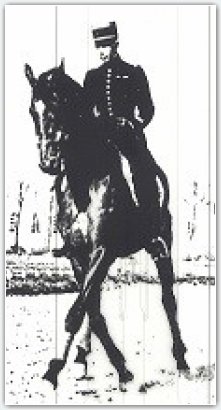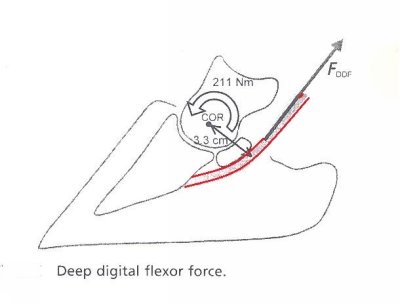Mechanoresponsiveness 13
Mechanoresponsiveness
Part 12
Jean Luc Cornille

“There is no glory in a victory gained at the expense of the horse’s soundness”. (Colonel Margot)
The aim of the series “mechanoresponsiveness” is awaking riders, trainers and practitioners to the wonders of equine biomechanics and the practical application of new knowledge. The horse’s physique is a master piece and this masterpiece can be exploited, as do most riding and training techniques, or enhanced, which is the aim of the science of motion. There is no equestrian art if there is no respect for the masterpiece, which is the horse’s biomechanics.
“Solutions require a different type of thinking than those that caused the problem.” (Albert Einstein) Instead, the equestrian education applies the same thinking but expects different results. Einstein defines doing the same thing but expecting different result as “stupidity.” Riding and training techniques regard doing the same thing but expecting different results as “tradition” and if the horse does not have the genius to understand what the trainer does not know and figure what the rider cannot explain, the horse “behaves” poorly.
What primitive training philosophies regard as behavior is in fact a plea for help. However, in order to hear the horse’s plea and provide adequate help, the rider needs sound understanding of the horse’s biomechanics. Equine functional anatomy as well as equine locomotion are complex. Today, the complexity is a fascinating wonder because science adds a new dimension to experience and provides an explanation to experience. “It is through science that we prove, but through intuition that we discover.” (Henri Poincare)
Each article of the series mechanoresponsiveness introduces a pertinent scientific discovery. The practical application explains how to become comfortable with new findings and how the horse benefits from the practical application of modern science. This instalment introduces recent discoveries and their direct application. Our approach is always inviting to a higher level through progressive education. If you have not read the previous articles of the mechanoresponsivenesss series you might have to read this one a few times and if you ask me to rewrite it in lay terms and in one paragraph; you are fired.
“Muscle force can only increase and decrease gradually, muscles cannot be either ‘on’ or ‘off’ momentarily.” (Liduin S. Meershoek and Anton J. van den Bogert, Mechanical analysis of locomotion). The concept has been previously explained through different investigations, including the work of Alan Wilson and his team on the “catapult” mechanism of the forelegs’ biceps. Muscles alone are too slow for the rapid movement of the front limb from push off into the swing phase. The biceps brachii does have a strong internal tendon that is put under optimal tension by the muscles cells during the stance. The tension of the tendon increases as the body moves forward over the leg and, when the hoof clears the ground, the internal tendon “catapults” the front limb into the swing phase. “The catapult mechanism is important as it enables the horse to protract the limb more quickly than would be possible with muscle contraction alone.” You can understand why touching the front legs with a whip or a bamboo pretending “enhancing” the front legs action, alters in fact the amplitude of the forelegs movement downgrading the genius of mother nature into pathetic pantomime.
The practical application is in line with the principle of natural frequency or cadence. Increase or decrease in the pressure of the rider’s lower legs needs to be progressive as well as any increase or decrease in muscle tone of the rider’s body. If you add the high tactile perception of the horse in the area of the rider legs, it is quite understandable that efficiency is greater with constant but extremely light contact of the rider lower legs and progressive and measured increase of pressure. Kicking the horse flanks with the heels or even worse with the spurs shut off the horse perception at tactile level and stimulates protective reflex contraction at muscular level. The motto is, react early but react peacefully and with respect. Giving to the horse the time to process avoids in many instances repetitive legs actions that are ultimately shutting off the horse perception.
“It has been estimated that the horse would need a muscle weighting 50KG to produce enough power to protract the forelimb at observed speed.” (Alan Wilson and all) Instead, the biceps spring-like mechanism, (biceps and internal tendon), provides the same power output from only 0,4 kg of tissue. The sophistication of the equine biomechanics is impressive and rewarding. It is rewarding because its allows identifying false theories and understand errors. Errors are part of evolution. Errors are the essence of scientific researches. Errors are the heart of experience. Errors are the fundamental principle of the horse’s mental processing. Our ancestors made errors for the simple reason that the scientific knowledge available at their time was in its infancy. There is a curious tendency in the equestrian world that grants infallibility to any riding and training principle referred to as classic. Under the name of tradition, “classical” trainers repeat our ancestors’ errors as the gospel submitting better athletes to dogmas created long before actual understanding of equine biomechanics.
Long ago, it was believed that muscles moved bones. With the evolution of knowledge, it was demonstrated that elastic structures, like tendons and ligaments, stored energy when elongated. This energy is released when they return to their normal length. At first, the concept was concentrated on the long and stiff tendons of the lower legs that are capable to store substantial amount of elastic energy. Soon, the concept of elastic strain energy applied also to broad sheets of elastic tissue covering some muscles and referred to as aponeurosis. Later, it was explained that muscles have the capacity of storing and reusind elastic strain energy even in the absence of tendon. “Apart from the role of tendons and collagen in energy storage, the muscle itself stores and recovers elastic strain energy, as elastic strain energy can occur in the absence of tendons” (Paul C. LaStayo, PT, PhD. John M. Woolf, PT, MS, ATC. Michael D. Lewek, PT. Lynn Snyde-Mackler, PT, ScD. Trugo Relch, BS. Stan L. Lindstedt, PhD. Eccentric Muscle Contractions: Their contribution to injury, prevention, rehabilitation, and sport. Journal of Orthopaedic & sports physical therapy. 557-571. Volume 33, NUMBER 10, October 2003)
Today, concepts totally ignored from our ancestors, are exposed questioning old beliefs. In some joints where there is only one muscle that can flex the joint. The deep digital flexor muscle for instance is the only muscle that can flex the coffin joint through the effect of the deep digital flexor tendon. The navicular ligaments can generate a flexor moment but only when the joint is hyper extended. Many muscles span more than one joint.  These muscles can absorb power at one joint and simultaneously, produce power at another joint. This has been described for the gastrocnemius muscle in human vertical jumping. At the end of the push off, the muscle generates positive power at the ankle and negative power at the knee.
These muscles can absorb power at one joint and simultaneously, produce power at another joint. This has been described for the gastrocnemius muscle in human vertical jumping. At the end of the push off, the muscle generates positive power at the ankle and negative power at the knee.
You don’t have to memorize all these sophisticated details of locomotion but they are part of the horse’s ability to move and perform soundly. Being aware of the complexity can indeed, save your horse from training and riding theories well packaged but based on archaic thinking. The purpose of advanced research studies is the practical application. The application for better performances and the application for soundness. For instance, a very common adaptation of the forelimbs kinematics to excessive load on the forehand is shifting the whole stance of the forelegs backward. This can be seen during the piaff when the horse is not properly balance and piaffs with the four legs on a coffee cup like a mountain goat on the top of a mountain peak. The kinematics adaptation is also visible at the trot as well as at the walk. Often at the walk, the font hoof impacts below the vertical of the point of the shoulder and the push off is executed far back under the belly.
The kinematics abnormality resulting from excessive load on the forelegs, alters proper production, absorption and transport of the distal limb, (lower limb) during the stance phase. First, you need to understand the concept of “transport”. As explained earlier, a muscle covering several joints can absorb power at one joint and simultaneously produce power at another joint. “This function of biarticular muscles is referred to as power transport between joints”. (Gregoire and al., 1984) In the lower limbs of horses, there are several more or less tendinous bi- or polyarticular muscles. No muscles fibers are needed to transport power and tendons can also transport power. The advantage of this system is that the horse lower limbs are lightweight while the joints can still contribute to the propulsion. All this sophisticate mechanism demands of course proper limbs kinematics. When the fore limbs kinematics is altered by excessive load, the advantages of “power transport” are altered.
At the walk, there is a down and up power flow in the lower part of the front leg. The stance of the front legs can be divided in five parts.
“In the first 20% of the stance phase, the power flows in proximally and is absorbed by the flexors of the fetlock joint.
From 20% till 45% the power flow is reversed: the fetlock muscle produce power, which is transported proximally, probably to propel the trunk. Simultaneously, the coffin flexors absorb some power from the hoof.
From 45% to 60%, the power flows in proximally and is absorbed by the fetlock and coffin joint flexors.
From 60% to 90%, the fetlock flexors gain produce power which is transported proximally. Simultaneously, the coffin flexors absorb power from the pastern and hoof.
In the final 10% of the stance phase, both the fetlock and coffin flexors produce power which is used to increase the mechanical energy of the distal segments.
The fetlock flexors have alternating periods of power absorption and power production. Part of this power might be stored as elastic energy in the long tendons of these muscles.” (Liduin S. Meershoek and Anton J. van den Bogert, Mechanical analysis of locomotion, 2003)
The beauty of the equestrian art is the beauty of the horse biomechanics. Soundness and performances are about orchestrating the horse physique for optimum use of its power and talent. Horses are good enough to perform well even with insufficient help of the rider but there is no glory and there is no class in this form of equitation. Class is another dimension. A wonderful world where the horse’s talent and intelligence is supported by the rider’s knowledge.
Jean Luc Cornille


 twitter
twitter facebook
facebook google
google stumbleupon
stumbleupon pinterest
pinterest linkedin
linkedin